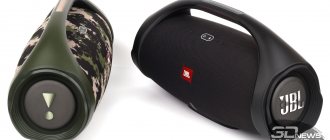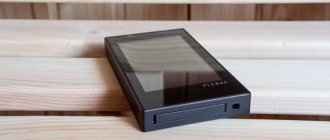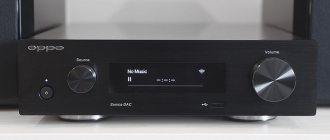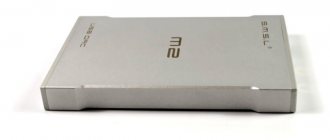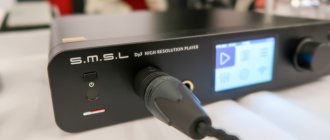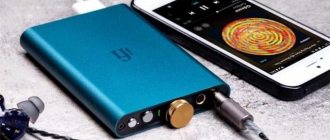SMSL SU-8: Hi-End DAC on modern hardware
I'm sure you're already waiting for something quite serious. And now, on my desk, of course, it’s not yet top, but it’s already a very notable Hi-End device: the SMSL SU-8 DAC. Among its advantages, it has RCA and balanced outputs, a bunch of digital inputs, proper power supply and different types of sound colors. In general, it’s a very interesting device, and today we’ll talk about it in detail.
Characteristics
- USB: XMOS xCore200
- DAC: 2 x ESS ES9038Q2M with 32-bit HyperStream II architecture
- Amplifiers: OPA1612
- Output Level: 2.0 Vrms, 4.0 Vrms (XLR)
- Audio resolution: up to 768 kHz/32 bit, DSD512
- Inputs: USB, OPT, COAX
- Outputs: RCA, XLR
- Dimensions: 185mm x 40mm x 125mm
- Weight: 1000 g
- OS: Windows 7,8,10; MACOS;
FIND OUT THE CURRENT PRICE FOR SMSL SU-8
Video version of the review
Unpacking and packaging
The device arrives in a fairly large box with a list of the main advantages and the Hi-Res certification logo.
Inside there is a warranty card, instruction manual, USB Type B cable and a very short power cord.
Contrary to tradition, this time I recommend looking through the instructions. Here you can find information on resetting the device to factory settings, view filter graphs and become familiar with the remote control.
The remote control itself is made in the best traditions of the SMSL company, including a couple of unused buttons.
It lies comfortably in the hand, and most importantly, it has functionality that simply has no other access.
Design/Ergonomics
The DAC case is compact, but very heavy. The manufacturer claims about 1 kilogram of weight.
It has a matte finish, which is nice because it won't pick up fingerprints.
The upper part of SU-8 is absolutely empty.
At the bottom there are 3 rubberized feet and a power mode switch.
As usual, I was lucky and the case is missing exactly one screw. Although maybe that's how it should be.
On the front we have another Hi-Res certification logo, a small but very bright display and a single function button. The button is made flush with the body, but has a small amount of play.
Its essence comes down to turning the device on and off and switching the active digital input.
Surprisingly, you can get into the settings only by pressing the middle button on the remote control. Further movement occurs by pressing this button again and using the left and right arrows.
In addition to selecting the input, there are 7 digital filters, 9 types of sound color made through the DSP DAC, brightness settings, and also what exactly will be displayed on the screen when the device is operating. There are three options: active input, operating frequency and volume.
The volume here, of course, is digital and is adjustable from 0 to 37 points.
At the rear, the manufacturer placed two outputs (classic RCA and balanced XLR) and three inputs (optical, coaxial and USB). Moreover, they all support native DSD: coaxial and optical up to DSD64, and USB up to DSD512.
By the input to the power cord, you can understand that this time it is implemented directly in the device body.
Software
I didn’t notice any special problems during operation, and the device doesn’t have any noticeable heating either. Any XMOS control panel will do as software; I didn’t even install anything additional.
The software here is standard, of course there is ASIO support. And I strongly recommend listening to the DAC through these drivers.
In Windows 10, not all frequencies are represented, but what is available is already within sight.
Parsing
Everything looks very presentable inside.
As you can see, I have the latest revision, version 1.2, with all the bugs fixed.
The device is easy to open; you just need to unscrew the 4 bottom screws around the perimeter and remove the top cover.
The star of the program is the modern XMOS xCore200 chip.
Next we find two top-end DACs ESS ES9038Q2M with 32-bit HyperStream II architecture.
Well, the manufacturer used the respectable OPA1612 as opamps.
Measurements
Based on measurements, SU-8, in my opinion, fully justifies its Hi-End quality. If anyone doesn’t know, this name was invented by marketers and does not oblige the manufacturer to anything at all. That is, these are devices made to suit the tastes and preferences of “respected people” and they don’t care about all sorts of graphs and measurements. The main thing is that it sounds decent. Well, in fact, this is how it is - the device sounds really cool, but according to the measurements... Well, these are the measurements - nothing special. Of course, we make allowances for the noise of the USB port.
The device also works from a smartphone, but there we get the “comb” already familiar from the previous review. I admit, I tried several brands of phones, installed different versions of the software player, all types of drivers for my audio interface. But no, it’s the hero of our review. Hi-End, such is Hi-End - the rules are not written for him.
All measurements were taken in 24-bit 48 kHz from the RCA output on the Focusrite Scarlett 2i2 audio interface.
Sound
But the sound of the SMSL SU-8, naturally, shows class. Switching different types of digital filters essentially does not change anything, and in the measurements there are not much differences visible.
All the variety of sound colors is also felt somewhere on the verge of placebo. But the graphs show that there is still a difference. Although distinguishing it by ear, even on professional monitors, is a task purely for trained ears.
The overall sound of the DAC is centered, that is, without distortion to the lower or upper part of the range. And, in my opinion, this is the most correct approach to building sound.
The low frequencies are deep and at the same time fast and textured. So the bass guitar, double bass and various electronic tones build the range as correctly and measuredly as possible. Do you want to “stick to” the rail bass? - yes please, everything is literally in full view.
The mid frequencies are a particular delight. Thanks to the well-developed bass, they receive gorgeous physicality and development from their lowest to highest parts. The vocals are slightly softened and at the same time transparent, like spring water. You literally dive into it, forgetting to breathe. String and wind instruments also reveal their high-frequency components. All sorts of echoes, rattles, reverberation elements - everything develops in separate layers. This is usually called layering.
Naturally, there are no restrictions on genres and there cannot be. The stage is constructed competently, the timbres are absolutely realistic. In general, the sound of the SMSL SU-8 is striking, first of all, with its special softness and at the same time purity, detail and depth of the scene. Do you like listening to an orchestra? — The DAC will allow you to get maximum information and in general you can extract everything that is possible from the track. A very good sounding device. From the category: “I want this for myself too.”
conclusions
As a result, the device is certainly a test: everything is done wisely inside, the measurements are more or less, it looks cool, there is an opportunity to play with filters and sound color, there is a remote control, balanced outputs and all kinds of digital inputs. In general, a very good solution for your money. Today the price tag is about 16,000 rubles.
FIND OUT THE CURRENT PRICE FOR SMSL SU-8
SMSL Sanskrit 10th MK II (DAC AK4493) in color
There were films where it was indicated at the beginning that they were in color.
This is the title I wanted to make regarding the review of the SMSL Sanskrit 10th MK II DAC (DAC AK4493) that came into my system. I didn’t expect revelations, curiosity about where SMSL’s desire for the best specs led, as well as excellent components (AK4493, XMOS) pushed me to buy this device.
What do you expect from buying a budget DAC, what makes you buy budget components in the first place? Hope for a miracle, for the alluring “what if.” Very rarely, but it works.
Taking it out of the box, on which, in addition to the standard image of the SMSL Sanskrit 10th MK II DAC, there was the coveted sticker - VER2.
Those. This is a new version of the DAC on the latest chip from Asahi Kasei - AK4493.
AK4493 is an all-around improved version of the “old” flagship AK4490 chip, and retains the characteristic sound of its ancestor.
Externally, the SMSL Sanskrit 10th MK II DAC looks beautiful - I liked it. This model is available in three colors - red, blue and black. But the subtitle “in color” does not mean a difference in color, but more on that later.
I had some difficulties regarding the power connection. The developers recommend using separate external linear power, rather than powering the DAC from the same USB through which data is received. To do this, the device has two USB connectors - one for power only, the second for data.
Unfortunately, it didn’t work out to connect to a high-quality external linear power supply - it turned out that I didn’t have the necessary adapter, so the issue of improving sound quality will be further explored in the future; according to the developers, high-quality power improves sound quality.
I could only use the phone charger as a separate power supply, I couldn’t figure out anything better, so this is the worst possible connection.
The second point is the choice of interface. In my large system, I can only connect a DAC via coaxial (via an external transport/board CM6631a), and the coaxial input in the SMSL Sanskrit 10th MK II is of the lowest quality, has characteristics that are globally worse than the USB input in terms of signal-to-noise ratio.
Jitter rake on coax (Coax in)
Almost perfect USB
Those. I did everything that could be done badly for this DAC. And besides, I connected a budget device to a top Hi-End amplifier + to acoustics of crazy transparency, which made it possible to hear the capabilities of the SMSL Sanskrit 10th MK II, which in this case is not limited by the imperfections of the system.
IN COLOR
And now why in color? This expression refers to the sound of a DAC.
I didn’t expect revelations from the budget DAC SMSL Sanskrit 10th MK II at all, it’s much more pleasant to be wrong. Moreover, lately I have mostly made mistakes in the negative direction; the purchases I made were simply not to my liking or did not evoke any emotions - these were expensive things, such as Denafrips Ares II, and budget ones, such as cables or ultra-affordable DACs.
But with SMSL Sanskrit 10th MK II, from the very first sounds I realized that I had hit the bull's eye and was very surprised by it.
Probably at some stage the race for the characteristics of the SMSL company turned into a new quality and the result was SOUND.
In the face of SMSL Sanskrit 10th MK II (DAC AK4493) I suddenly heard an incredibly musical device. Yes, it’s all that damned word, “musicality,” which is hardly understandable in a formal sense.
But as in the case, for example, with the Tannoy Sixses 615 acoustics, I immediately felt a buzz from the sound and was dragged into audio nirvana.
On the one hand, the sound was muddy, there was a persistent underlay underneath all the sounds, on the other hand, the class of the chip itself was so high that I couldn’t complain that I couldn’t hear something. Complex moments were perfectly clearly reproduced, the stereo bass was sometimes felt, the guitar passages did not fall into mush or synthetics, they were quite rich.
The timbral balance seemed perfectly maintained. The amount of high and low frequencies was simply a reference for hearing. Having started going through my collection of music, I came to the conclusion that the density of the low end still slightly dominates in some recordings, but I haven’t gone crazy yet to find fault with a very budget device.
What I liked most from the very first seconds of listening was the tenderness of the sound, the sweet presentation that is often characteristic of the sound of a very high-end amplifier, but here it was given by a budget DAC.
Having turned on Sting's album, I couldn't tear myself away from it until the bitter end, after which I wanted more. There are a number of songs in this album where Sting began to get carried away, he began to scream expressively, and on many systems such moments begin to tire or irritate, but in the performance of SMSL Sanskrit 10th MK II there was no negative feeling, the tenderness of the sounds was still caressing the ear, every drum and The cymbal was frankly pleasing with its sound.
Very tender, tasty, analogue.
Lack of details? But here I wouldn’t say so, given the general dullness of the sound (more precisely, the background), the instruments definitely did not hang separately in the air and there was no cosmic emptiness between them, they were located on a sweetish background substrate and all together it really “struck” the listener.
The cymbals did not degrade into syllables and bullshits, but were quite rich, but there was a certain selectivity, some minor sounds were shaded into the background, and some, on the contrary, were shown in extreme detail.
I really liked SMSL Sanskrit 10th MK II, but wait, don’t rush out and buy it if you’re a hell of an audiophile, because it’s a little unclear. This is the case when you are tired of catching sounds, but want the thrill of music, unity, melody, gentle sweetness - and this, to my unspeakable surprise, was given by SMSL Sanskrit 10th MK II from a company that for a very long time produced rather second-rate, albeit cheap components .
SMSL Sanskrit 10th MK II turned out to be a component for the soul. I listened to Sting and began to twitch my leg or arm, but not because I was hooked by the automated rhythm, but because I began to float on the wave of melody and wanted to wave my baton like a conductor.
The high ones were enough, the low ones were close to ideal in thickness for my taste and it was amazing.
When trying to find the muddiness and prove that this is a low-budget device, the listener again fell into the gentle music, heard details when he wanted to hear them and did not hear them otherwise, and forgot that he was going to analyze something.
Probably the new high-quality AK4493 chip and a good DAC circuit played a role in this audio magic.
I don’t know whether the same magic will happen on a higher-quality XMOS USB input, and with high-quality linear power supply - this is a question for further research into the discoveries of the new budget DAC from SMSL. I don’t presume to say that this was in the person of SMSL Sanskrit 10th MK II - an accidental revelation, or the result of the systematic work of engineers who ultimately led the company to this result - we’ll see, I’ll keep an eye on it.
The description as a "gentle sound" should not be considered slow or sluggish. The DAC is actually very fast, I turned on the thrash metal band Nasty Savage and they pulled out such things there that I would rather remain silent, but at the same time my ears did not experience harshness or fatigue, the gentle touch of the super-fast kick drum was gorgeous. It was something like sweetness in the sound on a very high-class equipment while maintaining all the nuances.
On my own behalf, I will say that I really liked the DAC, as a device for background listening, for enjoying, you can call it “analog” sound, gentle, sweetish. Using such a device as the only one in a high-end system is probably reckless and unjustified, but as a second DAC for the soul it’s great. For now, I plan to enjoy this DAC, losing the sterility and cosmic cold between which the sounds are frozen, but getting tenderness and a long, pleasant aftertaste from the music I listened to.
So, what we have with the budget SMSL Sanskrit 10th MK II, despite the fact that it can be called muddy (although all instruments are heard in sufficient detail, although some are slightly out of focus) and background, due to the obvious background underneath music (there is no black space, only gray from the illumination of nearby stars) and we will not hear the three-dimensionality of the room, as well as its dimensions and the atmosphere of space. But at the same time, we get such sound features that are not found in budget equipment - this is tenderness, the desire to listen endlessly, this is a certain sweetness, but not cloying, this is simply breathtaking musicality and it is not clear what else you want from a budget DAC. Top DACs don’t always have the concept of musicality, the desire to listen to it, but here it is.
Very smooth, simply wonderful tonal balance, ideal frequency ratio, nothing outweighs in any direction. The richness of the sound, no matter how funny it sounds despite all the background sound and muddiness - the timbral richness is present. the cymbals are rich in shades with a thick base, the drums are tasty and not synthetic, the strain, the scream does not cause irritation, but asks for more. In addition, the DAC is very fast.
Who is this DAC suitable for?
If you have a budget system, then of course it will do. If you have a very expensive system, but you want the most musical device in which you don’t need to analyze anything, but just sometimes relax in the background, it’s perfect as a second device. In any case, I am not going to tell you what to choose, I am only broadcasting my impressions and they are that SMSL Sanskrit 10th MK II is a DAC with such musicality that I have not seen for a long time.
As for the competitors in the form of Topping D10 and D30, the SMSL Sanskrit 10th MK II would be my absolute choice without a doubt. More sterile and precise, the D50 nevertheless shows itself to be more “synthetic” in timbre than the “cloudy” SMSL Sanskrit 10th MK II.
Classics sound rich, brass and strings sound excellent thanks to the new chip, with virtually no degradation. I was only able to detect degradation on the organ - it didn’t look like itself, and if you can’t imagine life without organ music, then you should probably look at a DAC that doesn’t cost $100. Otherwise, I didn’t see any genre features in the device. SMSL Sanskrit 10th MK II, although cloudy and not “serious”, from the point of view of a music lover, left the most wonderful impressions. I will think about keeping this device in my system on an ongoing basis depending on my mood, as something so musical that it seems like nonsense.
Chinese DAC and headphone amplifier clone: SMSL SD-1955+ and Lehmann BCL
Hello everyone, friends! I decided to share with you my successful experience of purchasing an audio path for headphones. The goal was to build a good-sounding system for reasonable money. There were already headphones, not from China. Briefly: Before purchasing the amplifier, I did not know what good sound was in headphones. I think I found out. Why is all this, in simple words?
DAC
(digital-to-analog converter, DAC, digital-audio converter) is a device for playing a digital audio signal through an analog amplifier.
Built-in PC sound cards, as a rule, do not provide truly high quality sound. An external digital-to-analog converter equipped with a USB connector in most cases provides better sound than built-in sound cards, leaving the PC only as a convenient “transport”. Source. Amplifier.
“Listening to high-impedance headphones without an amplifier is like watching TV from an indoor antenna. It's not just about volume - I've already come across the opinion of inexperienced people who think that an amplifier is needed only to make the headphones sound loud. An amplifier is required, first of all, to reveal the full sound range of the headphones. Without an amplifier, high-impedance headphones barely wheeze or squeak: there are no mid frequencies at all, the bass is barely visible, the highs are also barely audible, the sound is flat and very quiet. Together with the amplifier, a wide sound stage appears, full-blooded bass, the highs are much more intelligible, the harshness and harshness of the sound disappears, the separation of instruments is clearer, the volume level is any, even to the point of hearing loss.” Source.
Where it all started: Sennheiser HD 280 Pro
Why they
On the pages of one well-known Internet conference there was a discussion of desktop multimedia speakers TopDevice TDS-505. The topic went a little off-topic, where I was advised to pay attention to the Sennheiser HD 280 Pro monitor headphones - an excellent combination of price and quality. I became interested, googled it, found a lot of good reviews about these ears and, soon, bought them. At that time I had a Creative X-Fi music sound card built into the motherboard, Realtek. Having connected my new Sennheiser HD 280 to the Creative sound system, I was not delighted, and with the built-in Realtek one, things were even better, as it seemed to me. However, as I expected, both sound cards clearly did not “pump up” 64-Ohm headphones.
After reading the Internet, I realized that to unlock the potential of headphones, you definitely need either a sound card with a built-in amplifier (for example, such as ASUS Xonar Essence ST), or a separate ear amplifier. Of course, the second option seemed preferable to me, since a separate device, as a rule, always performs its functions better than a universal device. In addition, I still hoped to get at least something from my Creative sound system (as it later turned out, in vain). That is, I think I had a source of sound. In short, I decided to take an amplifier.
I wasn't ready to overpay for sound. Moreover, I didn’t know: would I hear the difference? Therefore, I decided to buy devices in order: if it doesn’t suit me, I’ll buy something else. Fortunately, the existing system can be modified if you have the hands, time and, inevitably, money.
Amplifier selection
I was inspired to buy a suitable device by an article on Habré: DIY preamplifier in class A. Lehmann BCL clone. At first I even wanted to assemble everything myself! But I still rejected this idea. So, I decided to order the complete device: board, case, transformer. For those who want to assemble everything themselves, the parts are sold separately, which works out a little cheaper. Boards are available both assembled and with loose elements. The advantage is that, if desired, parts can be replaced with better ones during the assembly process.
Ordered. The seller specifically noted that a 220 Volt version is needed. Almost 2 months later the parcel finally arrived. The process fell just during the post-New Year jam. Packaging: cardboard box, lined inside with a soft seal. I didn’t take a photo, and there’s no reason to, it came out fine. The kit contains nothing special: an amplifier, a power cable for our sockets and a headphone adapter from a mini-jack to a jack.
Exterior of Lehmann BCL
On the front panel there are 2 headphone jacks, a volume control and an LED that lights up when the device is turned on.
On the back of the device there is a connector for the power cord, a power button and left-right RCA line-in and out connectors. The device can be used as a preamplifier, which is why Out connectors are provided. I didn’t use the amp as a “pre” one.
The assembly is solid, the case is made well, nothing fell off during the shipping process. The top cover is heavy and can be removed by unscrewing 6 side screws. Bottom - 4 plastic legs. The weight of the device is 1470g. I'm not an electronics engineer, but in my opinion the board is well made. I definitely wouldn’t solder like that!
Sorry, it’s difficult for me to say which components are used, originals or fakes. But I think the components there are definitely not audiophile grade. According to reviews, many sooner or later change individual parts. To me, so far everything sounds very good. operational amplifier NE5532P
The device contains an operational amplifier (OP-amp) NE5532P. The simplest thing I was advised to do to improve the sound was to replace the op-amp with an OPA2134 and transfer it to A-class (solder a couple of resistors to the legs of the op-amp). Until I did this, I can’t find resistors. The operational amplifier itself can be changed without soldering - a collet connector is installed on the board, which easily allows you to change the op-amp to your taste.
The circuit is powered by a toroidal transformer R-Core transformer. The original Lehmann, after all, has a toroidal one, which does not cause any interference.
Impression
The amplifier was immediately connected to the Creative sound system. On the forums they warned that the device needs to be warmed up; out of the box the sound will not be cake. Yes, indeed, the sound was flat and dry, I did not experience much delight. Played .flac using foobar2000 via ASIO. I drove it a little, the situation improved, but there was no wow effect. The ears quickly got tired, and the process brought only discomfort. I decided to try with another sound source, namely the WD TV-live media player.
This is where I experienced delight for the first time! It already looked like something. There was no longer any fatigue from listening, the sound was natural and pleasant. Soft. I decided, purely for the sake of testing, to listen to Mozart’s “Requiem” and couldn’t turn it off! I listened to it completely without even noticing how time passed (about 40 minutes)! In general, I liked the amplifier.
Flaw
The amplifier also has a small drawback: a barely perceptible low-frequency noise can be heard in the headphones, probably from the mains, 50 Hertz. It does not depend on the position of the volume knob. When the volume is turned up to maximum, there is no additional noise in the headphones. I don’t know how to deal with it yet, it’s completely inaudible when listening, but I’d still like to remove it. As they wrote on the Doctorhead forum, you can get rid of it. I hope they get around to it. UPD: It dawned on me that the interference is most likely due to the transformer. If you replace it with a toroidal one, the hum should disappear.
No equalizer
I won’t describe the sound in words, for me it’s all very subjective. It’s difficult to describe, and I don’t know how. Let me just say that I decided to show my friend my purchase, he listened and listened and asked: “Doesn’t he have an equalizer?” - No. - Let's connect it to the computer. We connected it, he turned on the equalizer in AIMP, and turned up the bass. He gives it and says: “to me, this is how it should sound.” I said nothing. o_O On the contrary, I achieved sound without distortion, as intended by the author of the music. What I mean is that at first glance it may seem that the compositions do not sound the way you are used to hearing them. But this is just out of habit. When you listen to familiar compositions and so many new details are revealed in them that you could not even dream of, then you experience real delight. The smile never left my face at first: there are so many nuances in the composition! After that, it’s sad when familiar music comes from cheap speakers - you think: how much we don’t hear!
DAC
The thought that the media player did not give the full picture captivated me more and more, and soon I wanted something more. At a conference discussing DACs, I came across several admiring reviews of the SMSL SD-1955+. I realized that this was my option.
There are a lot of offers on both ebay and Aliexpress. I wanted a more or less “official” seller, if this can be said about Chinese products. Then it turned out that he does not send to Russia! But after some persuasion and a message that things were getting better at Russian Post, and I was ready to wait as long as I wanted, the seller agreed.
The parcel took a long time, almost 2 months. What pleased me about the packaging was that the branded cardboard box was wrapped in a thin layer of gas-filled polyethylene foam (GPE). Well, the traditional gray package. But it feels very interesting to the touch - it seems like a solid object, but at the same time it presses, as if you were holding a piece of penoplex.
Hole - I cut out the address
"Branded" box
What's included: • DAC • Switching power supply 9V/1.2A • USB (looks good) • Cord 2RCA - 2RCA (as a gift from the seller) • Instructions in Chinese and English
On the front panel there is a power button, a power indicator and three indicators for input signal modes: USB, optical and coaxial.
On the rear panel: • inputs: USB, optical, coaxial; • audio output (right-left); • power connector.
There are 4 soft rubber feet located at the bottom corners. Here you can see a seal that says “Warranty void if seal broken.” Apparently, in case of warranty proceedings with the manufacturer? It was really impossible to just peel off the seal, so I had to break it during disassembly.
The device itself is quite small, about 14cm in length (including protruding RCA terminals). Weight - 320g.
Compared to amplifier
The back cover is secured with four screws.
The board is pressed only by the back panel; there are no additional fasteners. It can be easily removed from the case box.
The DAC is assembled on AD1955A, DIR9001, TE7022L chips.
2 pieces were used as op-amps. OP275G and 1pc. NE5532.
After playing with the opamps I had, I found a more advantageous combination, in my opinion: 2 pcs. NE5532 and 1pc. OPA2134. Compared to the stock version, the pronounced, unpleasant mid frequencies are gone and volume and detail are added. The board, again, in my opinion, looks neat.
When the power supply is turned on, the device lights up the green LED of the power indicator. When you press the button for a long time (1 second), the device turns on, a relay sound is heard and the indicator diode lights up red. The input indicator also lights up. Cyclic selection is carried out by pressing the button once.
Impressions of the DAC
I connected it to the computer first. The DAC was identified as a USB audio device SMSL-1955+. For some reason he didn’t want to play in foobar2000, I think it’s something in foobar’s settings. I didn’t want to figure it out, so I turned it on via AIMP and it started playing. It played very well!
Then I connected it to the media player via optics. (I hope WD Tv live honestly gives me a digital signal? I would be grateful if you can tell me.) This is where all the beauty comes in! Even with closed headphones you can feel the volume and “air”. Music seems to be around you. The instruments have huge after-sounds; they fly off into the distance, creating the space of the composition. No extraneous backgrounds from the DAC were detected by ear. The device heats up moderately during operation.
With the advent of the DAC, the scene has expanded much! In the composition Another Brick In The Wall, I got the feeling that the kids were singing around me: “Hey, teacher, leave the kids alone!”, incredible breadth of the stage. Pink Floyd began to play in all its glory: careful work with sound made itself heard. I'm incredibly happy!
About the disadvantages of the DAC
The first thing that is strongly recommended to be replaced is the power supply: switching to linear (which has a transformer).
The power supply is pulsed, like a mobile phone.
This is due to the fact that the supplied power supply gives terrible interference.
Interference on the output of the pulse power supply 9V Source
So far I can’t say anything about improvement after replacing the power supply; I haven’t tried it.
The whole system
Connection diagram:
WD TV live
——[optics]——
DAC
——[RCA]——
Amplifier
——[jack]——
Headphones
In turn: Computer
——[WiFi]—-
Router
—-[LAN]—-
WD TV live
Price: • Lehmann clone amplifier assembly $111 + shipping $30 = $141 • DAC SMSL DAC SD-1955+ = $99 Total: $ 240
Headphones were bought for ~$100
Well, it's time to draw conclusions
The system as a whole: + good sound to a first approximation + relatively inexpensive system + possibility of replacing op-amps (without soldering)
+ USY: price 10 times lower than the original + USY: noise at max. volume does not appear + USY: can be used as a preamp + DAC: high sound detail, stage width + DAC: compact + DAC: plays from 3 sources to choose from
- USY: most likely, there are non-original parts - USY: there is a quiet 50Hz hum - DAC: not very successful op-amp OP275G, better to replace (personal opinion) - DAC: power supply inevitably needs to be replaced
Result:
For a music lover inexperienced with Stax headphones, such a set can be the first step towards Hi-Fi—Hi-End—Head-Fi sound (underline as appropriate). Perhaps this will be enough for most people. My wife, for example, cannot say what exactly has changed in the sound, but oh. I am sure that higher-end headphones (for example HD650) will be able to perform well in this combination.
And yes, finally
• This is my first purchase from China (US) • This is my first review • I apologize for the quality of the photos.
Cerangella
Thank you for your attention!


